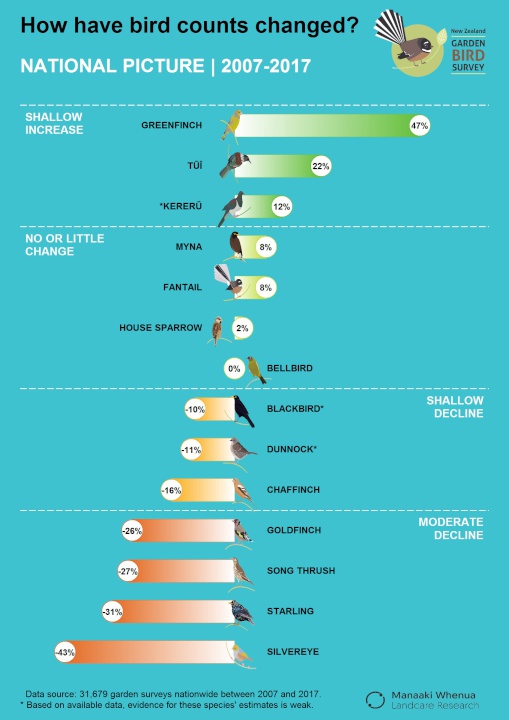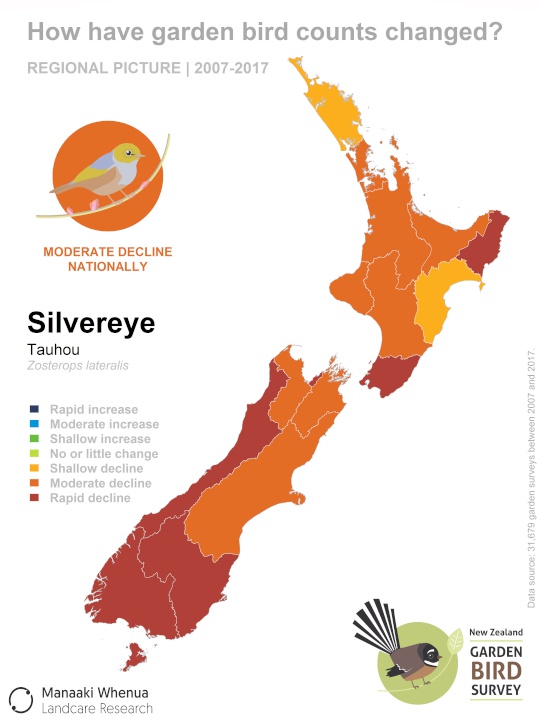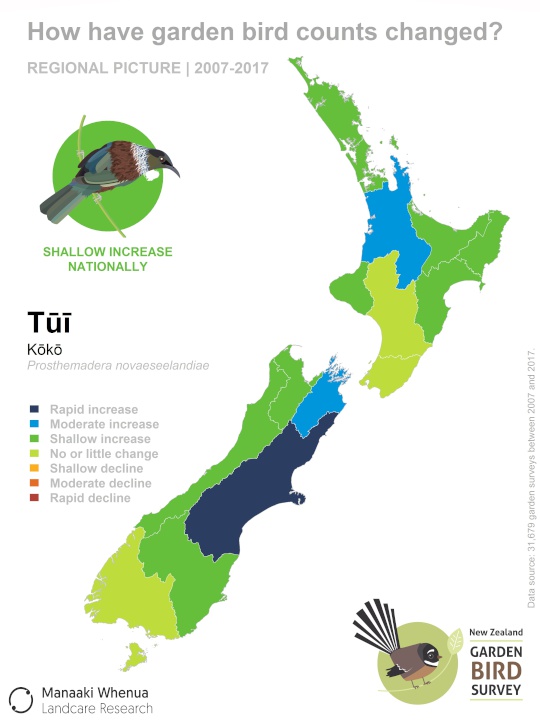Garden birds are signalling changes in our environment
www.landcareresearch.co.nz
New report shows garden birds are signalling changes in our environment
Tuesday 19th June
Birds are signaling major changes in our environment and a new report shows some of New Zealand’s birds are sounding the alarm.
‘Birds act as “backyard barometers”, telling us about the health of the environment we live in – and we should be listening,’ says Manaaki Whenua, ecologist Dr Catriona MacLeod.
The State of NZ Garden Birds 2017 | Te Āhua o ngā Manu o te Kāri I Aotearoa 2017, report was released by Manaaki Whenua Landcare Research on Tuesday.
This report draws on 31,000 bird counts gathered by volunteers in their backyards since 2007, as part of the New Zealand Garden Bird Survey.
Manaaki Whenua researchers have condensed this large information base into simple but powerful metrics – providing insights into how garden bird counts have changed from local to national scales.
This year’s report shows counts of one of our most common native garden birds, the silvereye (tauhou), also known as “waxeye”, is still declining. Counts have almost halved in gardens since the survey began, which researchers say could be a warning sign something is changing for the species.
“The silvereye has declined by 43% nationally,” says NZ Garden Bird Survey founder and Manaaki Whenua Research Associate, Dr Eric Spurr.
“Rapid declines in this species’ counts were detected in Southland, Otago, West Coast, Nelson, Wellington, and Gisborne regions.”
“We don’t yet fully understand what is driving these changes but increasingly warmer winters may mean silvereyes are less likely to come into gardens in search of food. They come more in cold winters when there’s snow on the hills,” he says. On the other hand, a cautiously positive picture is emerging for tūī, which could be the result of improved predator control in urban and rural landscapes.
“Among native species, tūī – and possibly kererū – counts have shown a shallow increase over the 11 years, while fantail and bellbird have remained at relatively similar levels,” says Dr Spurr.
Of the introduced species, only the greenfinch has increased (almost doubled) in counts since 2007.
Six of the most common species in our gardens (blackbird, dunnock, chaffinch, goldfinch, song thrush, and starling) have experienced shallow to moderate declines (10–31% over 11 years).
“It might be tempting to dismiss these declines as unimportant because these species were all introduced to New Zealand from Europe. However, these birds are signaling change in our urban and rural environments that we need to better understand,” says Dr MacLeod.
Dr MacLeod says without the New Zealand Garden Bird Survey, and the thousands of volunteers who have participated in it, these changes would have gone undocumented.
This year’s survey is taking place between 30 June and 8 July.





 Gordon Campbell: On The Americanising Of NZ’s Public Health System
Gordon Campbell: On The Americanising Of NZ’s Public Health System NZ Labour Party: Govt Health And Safety Changes Put Workers At Risk
NZ Labour Party: Govt Health And Safety Changes Put Workers At Risk Amnesty International Aotearoa New Zealand: Democracy At Risk
Amnesty International Aotearoa New Zealand: Democracy At Risk Walk Without Fear Trust: New Sentencing Reforms Aimed At Restoring Public Safety Welcomed
Walk Without Fear Trust: New Sentencing Reforms Aimed At Restoring Public Safety Welcomed Rio Tinto & NZAS: Archaeological Project Underway From Historic Excavations At Tiwai Point
Rio Tinto & NZAS: Archaeological Project Underway From Historic Excavations At Tiwai Point New Zealand Deerstalkers Association: NZDA Urges Hunters To Prioritise Safety This Roar Season
New Zealand Deerstalkers Association: NZDA Urges Hunters To Prioritise Safety This Roar Season PSA: 1000 Days Since Landmark Pay Equity Deal Expired - Workers Losing $145 A Week
PSA: 1000 Days Since Landmark Pay Equity Deal Expired - Workers Losing $145 A Week


